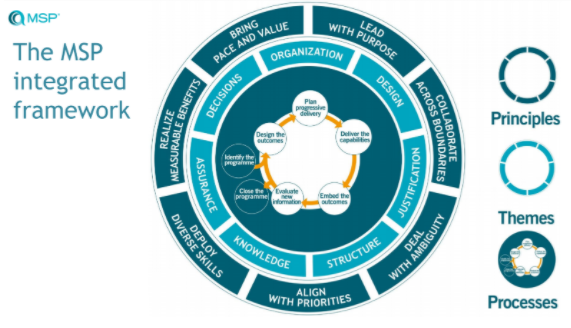MSP Guide 5th Edition

MSP (Managing Successful Programs) is a globally recognized Good Practice Guide for Program Management that is used by organizations to direct change investments.
Axelos recently published the 5th edition of the MSP guide, which had not been updated since 2011.
This new edition responds to a number of changes that have occurred in the world of program and project management since then.
Indeed, a great deal of research has been published over the last few years, showing the high failure rate of programs, whether they are transformation programs or large-scale programs.
The digital revolution, the speed of change, the rise of agile ways of working, and the increased volatility and uncertainty in all markets have led program management to evolve to meet these demands.
This new edition will help current and future program managers, and many other roles, to design, plan, lead and execute their programs and help organizations make their transformation program a real success.
MSP 4 vs MSP 5
The essence of what a program remains the same as it was with the 4th edition: it is temporary, it is focused on results and benefits, and it is concerned with leading several projects and other work.
The basic concepts (principles, themes, and processes) also still form the overall structure of the guide.
However, these have been revised with the following principles in mind:
- Ensure that MSP remains adaptable and flexible and can be used in a wide range of organizations and environments. There are many different drivers of change, and the MSP approach to program management must ensure that the organization’s investment in change is managed wisely.
- Provide guidance for a wide range of investments that benefit from program management, recognizing that the word “program” has many different meanings for organizations and that terms other than “programs” may be used by these organizations.
- Emphasize the incremental nature of a program and show how MSP allows cyclical progression to the desired future state. Organizations are complex, the external context is emergent, and the delivery of benefits and value creation generally cannot be achieved through a series of linear steps.
- Enable program teams to recognize the many ways in which outputs and changes can be delivered, including iterative (Agile), traditional, and hybrid approaches.
Key Elements of MSP 5
The MSP 5th edition emphasizes greater flexibility, adaptability, and responsiveness by taking an incremental approach to the program lifecycle and enabling organizational agility.
The MSP 5th edition consists of a set of principles, themes, and processes that provide a clear roadmap for the program life cycle and ensure successful organizational results.
The MSP guide offers 3 lenses:
- 7 universal principles
- 7 themes facilitating governance and essential controls
- 7 processes representing the incremental life cycle which, if flexible and adaptable, allows an orderly cyclical progression with clear decision criteria.

Source: webinar “OVERVIEW MSP 5th EDITION” – Axelos 2020
The overview of the revised key elements is as follows:
. Vision
An updated approach to the structure of a vision statement.
. Benefits
A reinforced vision of a key principle of SHP throughout the guide.
. Risks
A broader discussion of risks and risk mitigation across the program.
. Organizational Structure and Roles
Well-established roles within the MSP have been reviewed and updated, and new roles are being introduced and discussed.
. Business Case
One of the main challenges is to obtain funding for a program.
In the updated basic guide, this topic is discussed and provides a new approach to its development.
. Blueprint
A key element of MSP has evolved into the target operating model, and the MSP 5th edition explains its use and benefits in more detail.
. Stakeholder Engagement and Communications Planning
Key elements of the new working methods, responding to the main challenges of today’s program management.
Agile Program Management Integration
The MSP 5th edition offers the multimodal delivery mode, which allows multiple ways of working, depending on what suits you best during delivery.
The same program or project can combine different approaches to work, its components, with projects using iterative (agile), traditional or hybrid life cycles, or continuous improvement activities.
Leaders need to decide when to invest in addressing change drivers, for example:
- adopt disruptions and emerging technologies and trends,
- build new physical infrastructure,
- respond to societal expectations and policy changes,
- establish more effective working partnerships across supply chains,
- using scarce resources as efficiently as possible.
MSP is the perfect answer to multiple common challenges such as insufficient support from the board of directors, unclear decision making, unsustainable focus on benefits, lack of a clear idea of where the company is and wants to be, unrealistic expectations about the ability to bring about change, stakeholder engagement.
MSP has been designed both for any form of organization that needs to respond to changes in its sector to survive and thrive and for individuals (PRINCE2 certification holders, project managers, program managers, change managers).
Main Differences between Exams
The MSP 5th edition certification scheme includes only two levels: MSP Foundation and MSP Practitioner.
In addition to a completely redesigned program, there are several differences between the MSP 4th and 5th edition exams that will bring new benefits to candidates :
- The MSP Foundation exam has been streamlined so that candidates can now focus on learning MSP content, rather than learning to answer complex questions.
- The MSP Practitioner exam has also been simplified to give the candidate more time on the exam to focus on the questions and reduce the reading load.
- Both exams have seen a reduction in the number of questions for each level: the MSP Foundation exam has been reduced from 75 to 60 questions, and the MSP Practitioner exam has been reduced from 80 partial questions to 70 questions.
Despite the reduction in complexity and number of questions, the time allocated to write the exams remains at 60 minutes and 150 minutes respectively for MSP Foundation and MSP Practitioner. This is to ensure that candidates have sufficient time to be able to answer each question to the best of their ability. - Both exams have been refocused based on the cognitive ability (Bloom level) required. The MSP Foundation exam covers all key concepts at the level of knowledge and understanding (Bloom’s 1 and 2).
There are no new concepts introduced at the MSP Practitioner level; the exam simply assesses the same concepts at a higher cognitive level (Bloom’s 3 and 4), where the candidate is asked to apply and analyze the concepts in context.
The MSP 5th edition guide is much more focused on key concepts.
As a result, the candidate will benefit from a product and an assessment method that focuses on what is really crucial for a program manager.
Benefits of the MSP 5th Edition Method
- It aligns projects and programs with organizational strategy.
- It provides a disciplined approach to profit management that facilitates business changes.
- It ensures an appropriate division of responsibilities and obligations.
- It facilitates organizational agility.
- It helps to understand the risks associated with a program.
- It is a proven best practice in the successful implementation of organizational change through the application of program management.
Source: webinars, blog, and Axelos white paper.
Would you like to follow an MSP training course?
Our training is once again available in face-to-face and distance learning.
QRP is ISO 9001:2015 certified.
Contact our team at +41 (0)43 588 10 36 or switzerland@qrpinternational.com to learn more about our virtual classroom, face-to-face, or intra-company offers!







